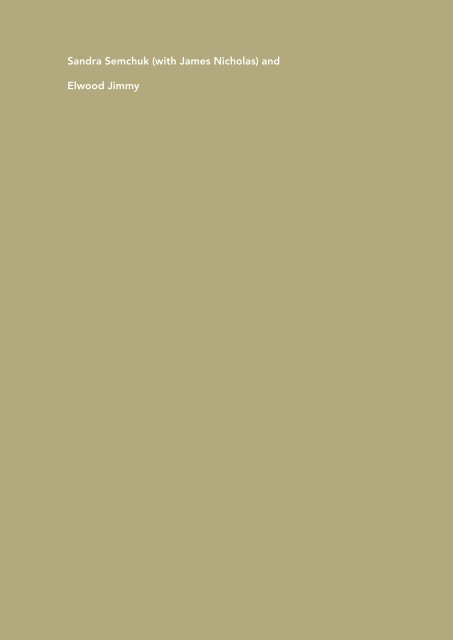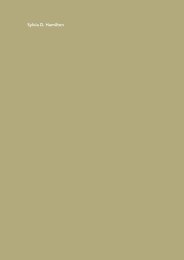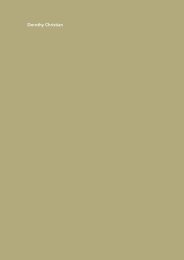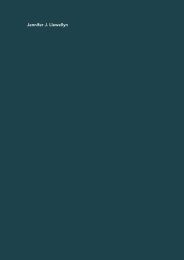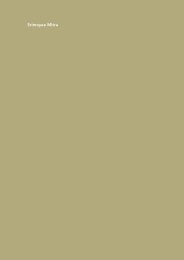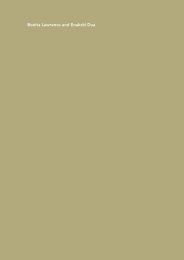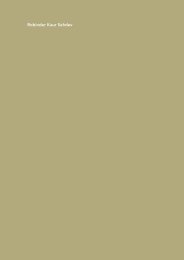and Elwood Jimmy - Speaking My Truth
and Elwood Jimmy - Speaking My Truth
and Elwood Jimmy - Speaking My Truth
Create successful ePaper yourself
Turn your PDF publications into a flip-book with our unique Google optimized e-Paper software.
S<strong>and</strong>ra Semchuk (with James Nicholas) <strong>and</strong><strong>Elwood</strong> <strong>Jimmy</strong>
54 | S<strong>and</strong>ra Semchuk <strong>and</strong> <strong>Elwood</strong> <strong>Jimmy</strong>
Cultivating Canada | 55
56 | S<strong>and</strong>ra Semchuk <strong>and</strong> <strong>Elwood</strong> <strong>Jimmy</strong>
Cultivating Canada | 57
Seeds of Lubestrok <strong>and</strong> Stolen Strength are two works from a substantial body ofwork that S<strong>and</strong>ra <strong>and</strong> James used to trace <strong>and</strong> deepen the dialogue between theindigenous <strong>and</strong> the non-indigenous in Canada. James <strong>and</strong> S<strong>and</strong>ra recognized that theirintercultural marriage was, in day-to-day life, an opportunity to make political, social,<strong>and</strong> psychological structures created by histories of colonialism, occupation of the l<strong>and</strong>,<strong>and</strong> racism visible to themselves <strong>and</strong> others through their art practices. The late JamesNicholas was Rock Cree from Nelson House, Manitoba. His great-gr<strong>and</strong>father wasmedicine man Pierre Moose. His parents, Lionel <strong>and</strong> Sarah, used traditional medicinesto help their community. James grew up traditionally on the trapline. At the age of eighthe was sent to residential school. In the 1970 s he studied in British Columbia workingwith Bob Manuel, son of native strategist George Manuel, while continuing his dialogueswith political activists Rodney Spence <strong>and</strong> Phil Fontaine from Manitoba. He providedleadership to his community in education, economic development, <strong>and</strong> government-togovernmentliaison. In the 1990 s James relocated to Vancouver where he engaged thearts of acting, writing, <strong>and</strong> art. He made many collaborative works with his wife, S<strong>and</strong>raSemchuk, <strong>and</strong> these challenge the known history of relations between First Nations<strong>and</strong> settler cultures. James was killed in 2007 when he fell from a cliff at a fishing campon the Fraser River. S<strong>and</strong>ra is Ukrainian Canadian, a photographer <strong>and</strong> videographer.S<strong>and</strong>ra grew up in a grocery store in Meadow Lake, Saskatchewan. Martin Semchuk wasa socialist who helped bring in medicare to Saskatchewan. Her mother ran the grocerystore. S<strong>and</strong>ra’s photographic collaborations <strong>and</strong> video works use autobiography <strong>and</strong>dialogue as the basis for recognition <strong>and</strong> identity. She collaborated with her fatherthrough four near-death experiences. As a partner in Treaties (where there are Treatiesin Canada), member of the settler culture <strong>and</strong> widow of James Nicholas, S<strong>and</strong>ra triesto disrupt myths that historically have shaped settler relations to First Nations, usingpersonal experience as a basis for storytelling. A number of collaborations with Jamesare still in production after his death. S<strong>and</strong>ra teaches at Emily Carr University of Art<strong>and</strong> Design in Vancouver <strong>and</strong> has recently completed a residency in Prince Albert,Saskatchewan, sponsored by the Indigenous Peoples Artists Collective <strong>and</strong> CommonWeal Community Arts. Her collaborations are exhibited nationally <strong>and</strong> internationally.<strong>Elwood</strong> <strong>Jimmy</strong> is originally from the Thunderchild First Nation in west centralSaskatchewan. Currently based in the city of Regina, he is the director of SâkêwêwakArtists’ Collective, southeastern Saskatchewan’s centre for contemporary Aboriginalart production, presentation, <strong>and</strong> education. Apart from his work with Sâkêwêwak,<strong>Elwood</strong> works independently as an artist, curator, <strong>and</strong> writer. His work has beenpresented across Canada in several communities from British Columbia to Quebec<strong>and</strong> the Northwest Territories.
‘On Loan’: Thoughts on stolen strength, seeds of lubestrok,seeds of truth, seeds of reconciliationA conversation on the collaborative work of S<strong>and</strong>ra Semchuk<strong>and</strong> James Nicholas 1Long before the arrival of the Europeans, papâmihâw asiniy falls to the earth; itis revered as a gift, a sign, a protector, as medicine from the Creator to the FirstPeoples of the plains.In 1821, George Millward McDougall is born. In 1860, as the newly appointedChairman of the Western Methodist Missionary District, McDougallestablishes <strong>and</strong> oversees missions all over the region that we now know asManitoba, Saskatchewan, <strong>and</strong> Alberta, including the Victoria Mission on thenorth bank of the North Saskatchewan River.In 1866, McDougall encounters papâmihâw asiniy.McDougall promptly <strong>and</strong> boldly steals papâmihâw asiniy from its originalsite in efforts to strip all vestiges of Aboriginal culture <strong>and</strong> world view. It ismoved to the farmyard of the Victoria Mission. McDougall believes by stealingpapâmihâw asiniy, the First Peoples will embrace the church. It has the oppositeeffect. Fearing more conflict, McDougall has papâmihâw asiniy taken toWinnipeg, where it is taken to Victoria College in Toronto, where it is taken to theRoyal Ontario Museum vault.I do not know the truth of this iron rock, this fallen meteor, as did my latehusb<strong>and</strong>, Pau was stik, James Nicholas, or as you, <strong>Elwood</strong>, do, or as yourmother does. I witnessed that James’s prayers were humble. Through them heunderstood Big Bear’s realization that when papâmihâw asiniy was stolen thenewcomers’ intentions were not good. This was a turning point in the relationsbetween those that had inherent rights to the l<strong>and</strong>, your people <strong>Elwood</strong>, <strong>and</strong>those that wanted them.<strong>My</strong> underst<strong>and</strong>ing of how the past is the present, is <strong>and</strong> is not lived through mylate husb<strong>and</strong>’s eyes, or from my awareness of you <strong>Elwood</strong>, your compassion,your history, <strong>and</strong> your struggle to help your people. I am not informed byspeaking Cree but through dialogue with James, <strong>and</strong> with you I have learnedsomething of the depth of the language <strong>and</strong> the laws <strong>and</strong> wisdom embedded inlanguage that are in resistance to colonization.Cultivating Canada | 59
60 | S<strong>and</strong>ra Semchuk <strong>and</strong> <strong>Elwood</strong> <strong>Jimmy</strong>
Cultivating Canada | 61
I have witnessed icons of cultures <strong>and</strong> civilizations destroyed in New York <strong>and</strong>in Baghdad as attempts to break people, but this theft you speak of is different.Papâmihâw asiniy is not an icon … not a symbol. “It has pim ma tis i win, lifeitself,” as James would tell me, “It is at once animate <strong>and</strong> inanimate.” How can I, agr<strong>and</strong>daughter of Ukrainian <strong>and</strong> Polish immigrants know this as you do? Howdo I hear the prophesies without my mind being clouded by guilt? Or denial <strong>and</strong>skepticism? How do I protect myself from the truth of how white history betrayed me,made me complicit in terrible historical wrongs?Medicine men <strong>and</strong> Elders foretell visions of plague, the loss of the buffalo herds,famine, <strong>and</strong> war with the removal of papâmihâw asiniy.All the visions of the medicine men <strong>and</strong> Elders come to fruition within a decade.Much of the work that James <strong>and</strong> I did together in dialogue was done here atMurray Lake in Saskatchewan. When the drought came, buffalo bones <strong>and</strong>teeth revealed a buffalo jump here. James carefully returned the bones to thelake. A dream told him to. This home is across the road from where Big Bearwas born on Jackfish Lake. We canoed there to honour him. A great featherrose vertically in the sky. James told me that day that Big Bear, a visionary <strong>and</strong>an orator <strong>and</strong> one of the leading chiefs among the buffalo-hunting northernPlains Cree, knew from the prophesies that the buffalo would disappear whenpapâmihâw asiniy was taken. Big Bear, James said, knew what his peoplewould face. Although the chains were not yet around his feet, around hiswrists—although he had not yet been charged with treason against a nationnot his own—Big Bear knew that the white man would force his Cree nation offtheir l<strong>and</strong>. To this day his people have not received even a reserve.<strong>Elwood</strong>, I know this has been no peaceful settlement. Prince Rupert’s evocationof “terra nullius” was a sham. Your people were here. Treaties were signedunder duress of possible extinction.Throughout the twentieth century, aggressive Western expansion continues torelocate <strong>and</strong> dislocate intact collective-based communities of First People <strong>and</strong>their connection to their l<strong>and</strong>, their spirit, their culture, their power.The accompanying migration <strong>and</strong> agricultural practices of non-Indigenouspeople transform the l<strong>and</strong> <strong>and</strong> its use.<strong>My</strong> Dad, Martin Semchuk, asked me, “Can you imagine what this l<strong>and</strong> wouldbe like if we had not arrived?” He gave a damn <strong>and</strong> did what he could to subvertcolonization even while participating in it. As Ukrainians we came as pawnsof the British to occupy the l<strong>and</strong>, to lay the foundation of a nation by breakingthe l<strong>and</strong>. We made the l<strong>and</strong> ours, like the old country, rich with agriculture by62 | S<strong>and</strong>ra Semchuk <strong>and</strong> <strong>Elwood</strong> <strong>Jimmy</strong>
eaking the prairie wool <strong>and</strong> clearing the l<strong>and</strong>. We brought our animals, ourplants, our beliefs, our fears, <strong>and</strong> our hopes for a new beginning, a chance tosurvive, to exist. Ukraine’s existence was denied. We did not see what was hereso much as we saw what we had lost <strong>and</strong> what we had been continually losingfor centuries. We attempted to recreate our homel<strong>and</strong> because that was whatwe knew, what we desired, <strong>and</strong> what sustained us, nourished us. It was whatwe had fought for, lost our lives for, suffered for … experienced rape, torture, <strong>and</strong>death. In 1885, when Poundmaker averted the massacre of his people, routedOtters’ militia <strong>and</strong> forced them to flee, serfdom for Ukrainians was abolishedby the Austro–Hungarian Empire. We were yet indentured to the l<strong>and</strong>, pawnsof other nations who took the grain we produced as payments for the small bitsof l<strong>and</strong> that could not easily sustain our children, our gr<strong>and</strong>children, <strong>and</strong> theirgr<strong>and</strong>children into the futures. We were still slaves. We had to buy our own l<strong>and</strong>back from the conquerors.Here we exp<strong>and</strong>ed. I was told that your people were forced to contract ontoreserves <strong>and</strong> use passes to go off reserve. On your reserve, given by Treaty 6,Thunderchild Reserve, the l<strong>and</strong> was taken yet again <strong>and</strong> sold to foreign buyerswhile your people were yet again forced off, dislocated onto poorer l<strong>and</strong>. Howdid this affect your mother’s life, your life, <strong>Elwood</strong>?There are few ecologies on earth as utterly transformed as Saskatchewan—this time by the plough. We wrote our names on the l<strong>and</strong> with the seeds webrought. Wheat created a monopoly, exp<strong>and</strong>ed at the expense of local flora,fauna, <strong>and</strong> knowledge.We did not know that like the Scottish who experienced the Clearances inScotl<strong>and</strong> <strong>and</strong> came for a new life in Canada, we were complicit in creating theechoes of the old violences here in the new country. We were after all invited,lured to come with promises of free l<strong>and</strong>.Whose l<strong>and</strong>?In 1972, papâmihâw asiniy—a connection between earth <strong>and</strong> sky, betweenCreator <strong>and</strong> Creations—makes a return engagement to the Plains region, thistime on loan to the Royal Alberta Museum from the United Church of Canada.I know you liked James, <strong>Elwood</strong>. You were one of the last people to speak withhim while he was alive. He respected you <strong>and</strong> was grateful for how you treatedour work.James <strong>and</strong> I witnessed papâmihâw asiniy in forced confinement at the RoyalAlberta Museum. Offerings are made there—tobacco <strong>and</strong> sweetgrass, sageCultivating Canada | 63
<strong>and</strong> cloths. First Nations people don’t have to pay. I do. James put his h<strong>and</strong>son papâmihâw asiniy <strong>and</strong> held them there for a long time. Did he give orreceive? We learned what we could about where papâmihâw asiniy fell.Could we find this sacred place? James was tired, weary from the battle<strong>and</strong> non-recognition. He collapsed in exhaustion at Rib Rocks. I rested. Wefound what we think is the site of papâmihâw asiniy’s l<strong>and</strong>ing, high on a hill.Prairie sage grows there.We will not show it in photographs.James prayed <strong>and</strong> made offerings. I joined him. We returned to the l<strong>and</strong> atMurray Lake. The plants he has watered, lubestrok, came in small seeds in mygreat-gr<strong>and</strong>mother’s pocket from Ukraine. It has grown large <strong>and</strong> strong. Weate from this plant <strong>and</strong> in the fall seeds are gathered so that it can be plantedagain. Each seed a choice, an action, a gesture of planting, a bending down tothe l<strong>and</strong>. James wrote my great-gr<strong>and</strong>mother’s story. He put the word Ka kissis kach e whak,2 Saskatchewan, in her mouth, a meal of river moving swiftlyaround a bend, a meal of l<strong>and</strong>, a province.I acknowledge to you, <strong>Elwood</strong>, that my family’s relocation dislocates FirstNations just as we had been dislocated from our homes over all of thosecenturies. I acknowledge that with this awareness comes responsibility.Without taking responsibility for my privilege <strong>and</strong> for the acts of mygr<strong>and</strong>parents I too become complicit in the ongoing systemic effects ofcolonization, racism, <strong>and</strong> non-recognition of the inherent rights <strong>and</strong> theextraordinary knowledges of First Nations, the laws of being specific to theirnations <strong>and</strong> to the diversity of individuals.By many accounts spread over centuries, papâmihâw asiniy grows heavierwith time—heavier in McDougall’s farmyard, heavier in Winnipeg, heavier inToronto.Heavier with the burden of theft by the people who claim to own it <strong>and</strong>presume they can ‘loan’ it?Heavier with the power <strong>and</strong> strength of a people, a power <strong>and</strong> strength—likepapâmihâw asiniy—temporarily on loan <strong>and</strong> one day restored?Coming to Canada gave my family possibilities to thrive, to diversify, <strong>and</strong>become more complex <strong>and</strong> innovative in the choices each member couldmake to create their own lives. These possibilities came at a great cost toyou from a First Nation as immigration overcame the Indigenous, as plants<strong>and</strong> animals were destroyed or pushed aside. The choices for First Nationsbecame truncated <strong>and</strong> limited within paradigms that were not their own.64 | S<strong>and</strong>ra Semchuk <strong>and</strong> <strong>Elwood</strong> <strong>Jimmy</strong>
This stole strength. This stole identity. Marshall Forchuk is a descendent of aUkrainian internee during WWI in Canada. Ukrainians, Serbians, Croatians,<strong>and</strong> others with Austro–Hungarian or German passports were imprisonedbehind barbed wired like animals, called enemy aliens, <strong>and</strong> forced to labourfor no reason other than where they were born. Forchuk said he learned fromhis father who escaped the camps,“You can steal my house, you can stealmy car <strong>and</strong> you have taken nothing. But if you steal my identity like we didwhen we put First Nations kids into residential schools then you have reallystolen something.” Ukrainians have only recently become white throughassimilation, another loss of culture. All those centuries under duress we heldour culture sacred. With wealth <strong>and</strong> security we too are losing culture <strong>and</strong>language—<strong>and</strong>, as James would say, our medicine bundles.Privilege has come at too high a cost. Ukrainians in Canada became respectedpolitical leaders <strong>and</strong> professional in every field. Yet our silence about theinjustices done to us re-forms too often in our silence in speaking out againstthe ongoing effects of colonization against First Nations <strong>and</strong> Métis. Do wehave many of the old terrors of speaking out against authority <strong>and</strong> abuse? Arewe unconsciously afraid of reprisals, being hurt in a less obvious way? Hasit become normalized to become perpetrators by denying the truth, creatingongoing suffering? This is not how we think of ourselves. We think of ourselvesas good people. Now we think of ourselves as people who have education,power, <strong>and</strong> authority—not as people who have been made crazy by theviolence <strong>and</strong> abuse of others. Yet we are still in the cycle of violence … polite<strong>and</strong> legal violence.Within a contemporary context, papâmihâw asiniy synthesizes a numberof very basic <strong>and</strong> universal concepts <strong>and</strong> laws of being. It also magnifiesthe challenges regarding the navigation <strong>and</strong> negotiation of the relationshipbetween the Indigenous <strong>and</strong> the non-Indigenous—the world views, the people,the animals, the minerals, the plants—that define <strong>and</strong> mark the story of thisplace.<strong>Elwood</strong>, I watch over <strong>and</strong> over in nature the violence <strong>and</strong> community buildingof plant <strong>and</strong> animal colonization, the unthinking ways in which plants <strong>and</strong>animals both dominate <strong>and</strong> cooperate in order to survive, create communities,<strong>and</strong> create endless adaptations. Can we think, I wonder, about what we aredoing <strong>and</strong> make choices that embrace the richness of the diversity of nations,the deep wealth that creates possibilities for the planet as it has for us?Can we acknowledge that we are a part of nature, all my relations’ pointsof views, the knowledges that First Nations have always shared freely withthose who were attentive? We are not, as we would believe, the generous ones,Cultivating Canada | 65
although generosity is the basis of many immigrant cultures as much as FirstNations cultures.“You don’t underst<strong>and</strong>,” James said, “Sharing is the law. The L<strong>and</strong> owns itself.”Who loans the l<strong>and</strong>? Who will restore the l<strong>and</strong>? The waters?By working with the l<strong>and</strong>, with our communities, we can work towardsspaces ofDecolonizationTransformation<strong>Truth</strong>ReconciliationAre we there yet? No.James’s best friend, Walter Wastesicoot, visiting now at this home on MurrayLake, was compelled to write the following in response to this text by <strong>Elwood</strong><strong>and</strong> me: As a residential school Survivor, I have learned much of the colonizer’smalice. He offers me reconciliation while I have an outst<strong>and</strong>ing case againsthim for sexual <strong>and</strong> physical abuse suffered while resident at one of hisinstitutions of assimilation. He offers my people reconciliation while he holdsour l<strong>and</strong>s <strong>and</strong> resources in abeyance, ensuring our continued survival by hish<strong>and</strong> only. Reconciliation is said to be a personal privilege, offered to one whohas made amends for past wrongs. Something is skewed in the colonizer’soffer of reconciliation. He carries with him centuries of shame, for which I <strong>and</strong>my people will continue to suffer in a marginalized existence in his hope forreconciliation.Does taking responsibility for the effects of colonization diminish the shame?But the seeds are there.66 | S<strong>and</strong>ra Semchuk <strong>and</strong> <strong>Elwood</strong> <strong>Jimmy</strong>
Notes1 <strong>Elwood</strong> <strong>Jimmy</strong> acknowledges the following resources that were helpful in composingthis interaction with S<strong>and</strong>ra’s <strong>and</strong> James’s artwork: The Alberta Encyclopedia <strong>and</strong> theRoyal Alberta Museum; Cuth<strong>and</strong>, Doug (2007). Askiwina—A Cree World. Regina, SK:Coteau Books; the Blue Quills First Nations College website (available at: http://www.bluequills.ca/); <strong>and</strong> the words <strong>and</strong> thoughts of others, including my mom, who knewabout the stone.2 Ka kiss is kach e whak is the spelling of the Rock Cree word used by the late JamesNicholas as he understood to be the basis for the word, Saskatchewan. It is this versionof the word that appears in the photographic installation.Cultivating Canada | 67
68 | S<strong>and</strong>ra Semchuk <strong>and</strong> <strong>Elwood</strong> <strong>Jimmy</strong>


